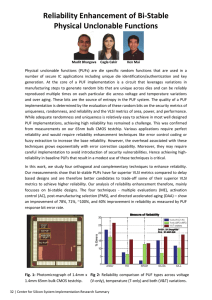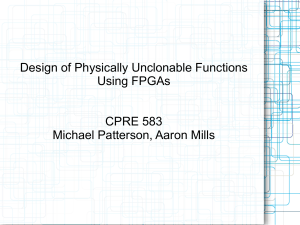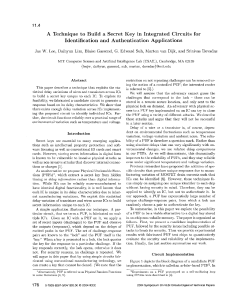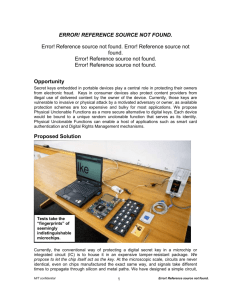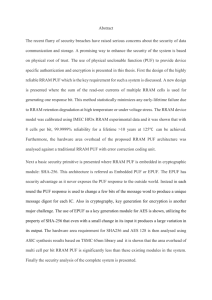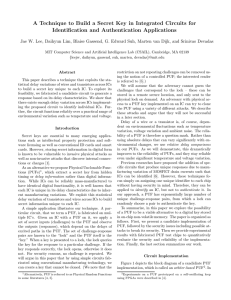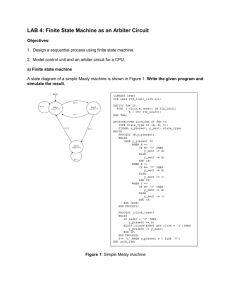A Technique to Build a Secret Key in Integrated Circuits for
advertisement
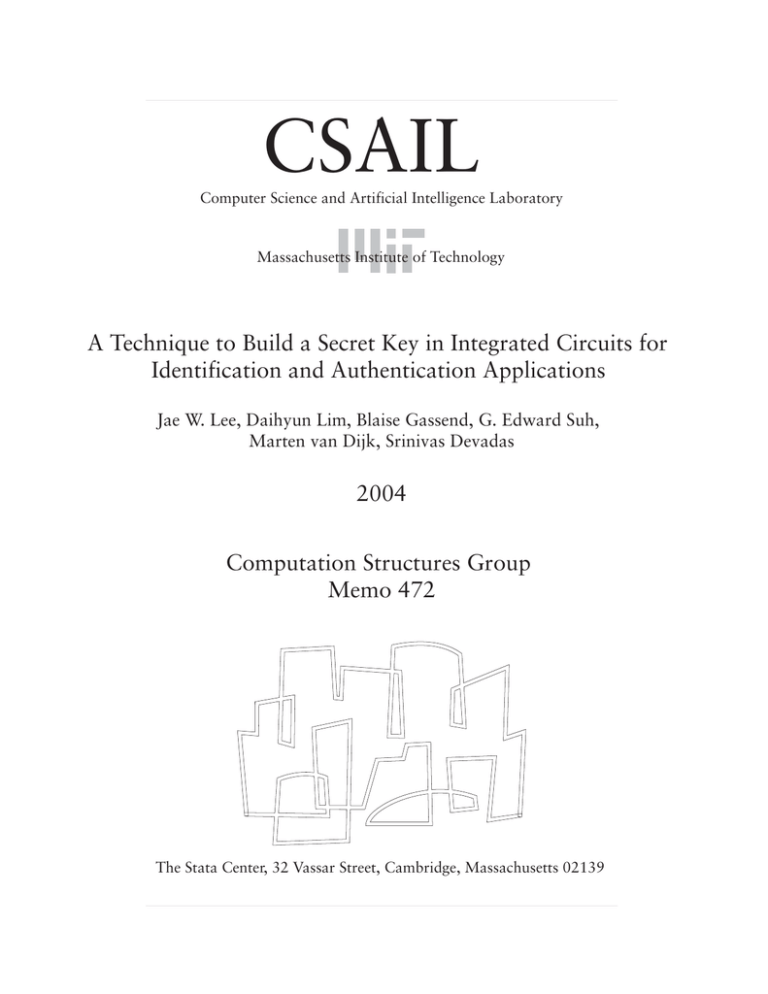
CSAIL
Computer Science and Artificial Intelligence Laboratory
Massachusetts Institute of Technology
A Technique to Build a Secret Key in Integrated Circuits for
Identification and Authentication Applications
Jae W. Lee, Daihyun Lim, Blaise Gassend, G. Edward Suh,
Marten van Dijk, Srinivas Devadas
2004
Computation Structures Group
Memo 472
The Stata Center, 32 Vassar Street, Cambridge, Massachusetts 02139
A Technique to Build a Secret Key in Integrated Circuits for
Identification and Authentication Applications
Jae W. Lee, Daihyun Lim, Blaise Gassend, G. Edward Suh, Marten van Dijk, and Srinivas Devadas
MIT Computer Science and Artificial Intelligence Lab (CSAIL), Cambridge, MA 02139
{leejw, daihyun, gassend, suh, marten, devadas}@mit.edu
Abstract
This paper describes a technique that exploits the statistical delay variations of wires and transistors across ICs
to build a secret key unique to each IC. To explore its
feasibility, we fabricated a candidate circuit to generate a
response based on its delay characteristics. We show that
there exists enough delay variation across ICs implementing the proposed circuit to identify individual ICs. Further, the circuit functions reliably over a practical range of
environmental variation such as temperature and voltage.
Introduction
Secret keys are essential to many emerging applications such as intellectual property protection and software licensing as well as conventional ID cards and smart
cards. However, storing secret information in digital form
is known to be vulnerable to invasive physical attacks as
well as non-invasive attacks that discover internal connections or charges [1].
As an alternative we propose Physical Unclonable Functions (PUFs)1 , which extract a secret key from hidden
timing or delay information rather than digital information. While ICs can be reliably mass-manufactured to
have identical digital functionality, it is well known that
each IC is unique in its delay characteristics due to inherent manufacturing variations. We exploit this statistical
delay variation of transistors and wires across ICs to build
secret information unique to each IC.
A simple application illustrates our technique. A particular circuit, that we term a PUF, is fabricated on multiple IC’s. Given an IC with a PUF on it, we apply a
set of secret inputs (challenges) to the PUF and observe
the outputs (responses), which depend on the delays of
excited paths in the PUF. The set of challenge-response
pairs are known to the “lock” and the PUF itself is the
“key.” When a key is presented to a lock, the lock queries
the key for the response to a particular challenge. If the
key responds correctly, the lock opens, otherwise it does
not. For security reasons, no challenge is repeated. We
will argue in this paper that by using simple circuits fabricated using conventional manufacturing technology, we
can create a key that cannot be cloned. (We note that the
1 Alternatively, PUF is referred to as Physical Random Functions
in some literatures [4, 5].
restriction on not repeating challenges can be removed using the notion of a controlled PUF; the interested reader
is referred to [5].)
We will assume that the adversary cannot guess the
challenges that correspond to the lock – these can be
stored in a remote secure location, and only sent to the
physical lock on demand. An adversary with physical access to a PUF key implemented on an IC can try to clone
the PUF using a variety of different attacks. We describe
these attacks and argue that they will not be successful
in a later section.
Delay of a wire or a transistor is, of course, dependent on environmental fluctuations such as temperature
variation, voltage variation and ambient noise. The reliability of a PUF is therefore a question mark. Rather than
using absolute delays that can vary significantly with environmental changes, we use relative delay comparisons
in our PUFs. As we will demonstrate, this dramatically
improves to the reliability of PUFs, and they stay reliable
even under significant temperature and voltage variation.
Previous researches have proposed the addition of specific circuits that produce unique responses due to manufacturing variation of MOSFET drain currents such that
ICs can be identified [6]. However, these techniques focus simply on assigning one unique identifier to each chip
without having security in mind. Therefore, they can be
applied to identify an IC, but not to authenticate it. In
our approach, a PUF has exponentially large number of
unique challenge-response pairs, from which a lock can
randomly choose a pair to authenticate the key.
To summarize, in this paper we explore the possibility
of a PUF to be a viable alternative to a digital key stored
in on-chip non-volatile memory. The paper is organized as
follows. First, we present a candidate implementation of
PUF, followed by the security issues including possible attacks to break its security. Then we provide experimental
results with fabricated PUF test chips to quantitatively
evaluate the security and reliability of the implementation. Finally, the last section summarizes our work.
Circuit Implementation
Figure 1 depicts the block diagram of a candidiate PUF
implementation, which is called an arbiter-based PUF2 . In
2 Experiments on a PUF prototyped on a self-oscillating loop
using FPGAs were described in [4].
this implementation, we excite two delay paths simultaneously and make the transitions race against each other.
Then the arbiter block at the output determines which
rising edge arrives first and sets its output to 0 or 1 depending on the winner. This circuit takes an n-bit challenge (bi ) as an input to configure the delay paths and
generates a one-bit response as an output. In our test
chip, n is 64.
the delay circuits effectively cover the entire chip. This
layout technique makes it extremely hard for an adversary
to probe the internal nodes to read out a logic value without breaking the PUF, i.e., without changing the delays
of wires or transistors.
Security of Arbiter-based PUF
There are at least two requirements for PUF to be a
viable alternative to a digital key – security and reliability. For security, measurable delay variation must be
large enough to distinguish chips fabricated with the same
technology, masks, and even on the same wafer. If there
is very little random variation of delay across ICs, an adversary can easily predict the behavior of a specific PUF
either by fabricating another IC or by building a model
for it, resulting in duplication of the key.
For reliability, the response of the circuit to a given
challenge should be consistent for repeated measurements
over a practical range of environmental variation such as
temperature and power supply voltage. Otherwise, even
with a valid key we would have difficulties in checking its
authenticity.
The most plausible attacks are described below.
Fig. 1. Arbiter-based PUF circuit (basic arbiter scheme).
Figure 2 shows the details of the switch component.
This block interconnects its two input ports (i0 and i1 )
to the output ports (o0 and o1 ) with different configurations depending on the control bit (bi ); for bi =0 the paths
go straight through, while for bi =1 they are crossed. It
is simply implemented with a pair of 2-to-1 muxes and
buffers. For the arbiter, we used a simple transparent
latch with an active-low enable input in our test chip.
(We note that this arbiter favors the path to output 0
because it is preset to 0 and requires a setup time constraint to switch to 1. This skew was compensated for by
fixing a small number of most significant challenge bits to
effectively lengthen the path for 0.)
Fig. 2. Implementation of a switch component.
If the racing paths are symmetric in the layout regardless of the challenge bits and the arbiter is not biased
to either path, a response is equally likely to be 0 or 1,
and its value is determined only by the statistical delay
variation in the fabricated ICs. Consequently, we wish to
have paths to be as symmetric as possible to give a PUF
enough randomness to function as a security primitive.
In our test chip, we carefully placed and routed the
cells, for symmetric paths, and also so that the wires on
1. An adversary could attempt to clone a PUF by exhaustively enumerating all challenge-response pairs,
but this requires applying an exponentially large
number of challenges and observing their responses.
2. An adversary can attempt to fabricate a counterfeit
PUF that produces exactly the same responses as the
original PUF for all challenges. However, if there is
enough process variation that cannot be easily controlled or eliminated by manufacturers, he will have
to fabricate a huge number of ICs.
3. An adversary can open up the package of a PUF chip
and attempt to measure device delays of the circuit
by probing or monitoring internal devices. Then he
may use these measured delays in a sophisticated timing model to predict the behavior of the circuit to a
given random challenge. However, probing with sufficient precision is likely to be very difficult because
interaction between the probe and the circuit will directly influence the behavior of the circuit. Besides,
any damage on the delay paths affects capacitive coupling between wires to change delay characteristics,
effectively destroying the PUF key.
4. Non-invasive model building attacks are also possible. First, an adversary can use a publicly available mask description of IC/PUF to build a timingaccurate model with a polynomial number of parameters. Then, he can apply many random or chosen
challenges, and monitor the responses to calculate
those parameters. If his model can predict the response of a real chip with a very high probability,
it breaks the security of PUF by building a “virtual counterfeit.” In case that the modeling attack
Power supply voltage(V) (reference voltage = 1.8V)
1.76
5
Noise Probability of Environmental Variations(%)
is a concern, we can make the modeling task much
harder by adding more nonlinearity [2]. One of them
is the feed-forward arbiter scheme depicted in Figure
3, where one or more challenge bits are determined
by the racing result in an intermediate stage instead
of being provided by a user.
1.77
1.78
1.79
1.8
1.81
1.82
1.83
1.84
1.85
5
Max temperature variation(4.82%)
4.5
4.5
4
4
Max voltage variation( 3.74%)
3.5
3.5
3
3
2.5
2.5
2
2
1.5
1.5
+:Voltage variations
1
1
Measurement Noise(0.7%)
0.5
0
5
10
15
20
25
30
35
40
0.5
45
Difference from reference temperature(27C) (C)
Fig. 3. Adding unknown challenge bits using feed-forward
arbiters (feed-forward arbiter scheme).
Experimental Results
This section demonstrates the security and the reliability of our PUF circuit with experimental results from
fabricated ICs.
A. Interchip Variation
To quantify the delay variation across ICs, we define
the interchip variation (τ ) as the probability that the first
measured response for a given challenge on a first chip is
different from the first measured response for the same
challenge on a second chip. We call these first measured
responses reference responses.
To reduce the measurement noise, the PUF computes
each response as the majority out of 11 repeated measurements. In this set up, we used 37 test chips to estimate τ ≈ 23% for the basic arbiter scheme. For the
feed-forward arbiter scheme, τ increases to 40%.
B. Reliability
To be useful, a PUF should reliably generate the same
response for a given challenge. Unfortunately, environmental variations, instabilities in the circuit, and aging
may cause a PUF to produce a response different from
the reference response. To quantify the effect of these
variations, we define the noise (µ) as the probability that
a newly measured response is different from the corresponding reference response.
First, temperature or supply voltage variations can significantly change the circuit delay, and lead to unexpected
responses. In fact, the delay variations due to environmental variations can be orders of magnitude larger than
the manufacturaing variations.
Fortunately, the arbiter-based PUF is very robust to
environmental variations because the response relies on
the difference of delays between two adjacent paths, instead of their absolute values. Consequently, the response
remains consistent unless the faster path becomes slower.
Figure 4 shows the amount of noise introduced by the
temperature (µt ) and voltage variations (µv ) for the basic
Fig. 4. The amount of noises from temperature and power
supply voltage variations with the basic arbiter scheme.
arbiter scheme. The reference responses are recorded at
27 degrees Celsius and 1.8V power supply voltage. The
noise is evaluated using 10000 challenges. Even if the
temperature increases 40 degrees to 67 degrees Celsius,
µt ≈ 4.8%. Also, with ± 2% power supply voltage variation, µv ≈ 3.7%. Both µt and µv are well below the
interchip variation of 23%.
Second, a PUF response may change due to variations
within the circuit even without environmental variation,
which is called measurement noise (µm ). For example,
junction temperatures or internal voltages may slightly
fluctuate as the circuit operates, and change the delay
characteristics. For some challenges, a setup time violation for the arbiter latch may lead to an unpredictable
response. In the reference environment, we estimated
µm ≈ 0.7% for the basic arbiter scheme and µm ≈ 2.2%
for the feed-forward arbiter scheme.
Finally, aging may change the PUF characteristics.
Electromigration and hot-carrier effects cause long-term
degradation of the reliability of interconnects and transistors [3]. In most applications, the PUF circuits will age
much slower than other processing elements because they
only get activated to generate a secret. While we believe
that the effect of aging is not a major problem compared
with the environmental variations, we plan to run longterm aging experiments whose results are not available at
this time.
C. Modeling Complexity
Currently, for the basic arbiter scheme, our best noninvasive model building attack achieves about 97% accuracy in predicting the response of a given random challenge using a machine learning algorithm. Note that
the error rate of 3% is still significantly higher than
µm ≈ 0.7% but that it is less than µt or µv . This means
that the basic arbiter scheme can only be used for authentication purposes in the reference environment.
The feed-forward arbiter scheme appears to have significantly higher modeling complexity due to the nonlinearities introduced by the additional arbiters. So far,
we have not been able to find a successful modeling attack
that results in accurate predictions.
D. Identification/Authentication Capability
Given the interchip variation τ and noise µ, we can estimate the identification/authentication capability of the
proposed PUF implementation. First, the probability
that at least 2t + 1 out of k reference responses differ
between two chips is equal to
a=1−
2t X
k
i=0
i
τ i (1 − τ )k−i .
(1)
For a single chip, the probability that at most t out
of k responses differ from the corresponding reference responses is
k
X
k j
b=1−
µ (1 − µ)k−j .
j
j=t+1
The test chip was built in TSMC’s 0.18 µm, single-poly,
6-level metal process with standard cells, whose die photo
is shown in Figure 5. It contains 8 sets of the arbiter circuit generating an 8-bit response for a challenge and a
JTAG-like serial interface, and measures a total area of
1212 µm x 1212 µm. It operates at 100 MHz.
Our evaluation indicates that there exists significant
delay variation of wires and transistors across ICs implementing this circuit, and that the idea of leveraging this
variation to uniquely identify and authenticate an IC is
promising. However, there are open issues that should
be addressed for PUFs to be deployed in real applications. For example, it should be shown to be resistant
against more elaborate modeling and other types of attacks, and additional reliability issues (e.g., the effects of
aging) should be resolved.
(2)
From (1) and (2), the probability of being able to identify N chips using a set of k challenges is at least3
N
N
p = a( 2 ) bN ≈ (1 −
(1 − a))(1 − N (1 − b)).
2
For the basic arbiter scheme in a constant environment,
τ ≈ 0.2 and µ ≈ 0.007, and we can distinguish N =
109 chips with probability at least p ≈ 1 − 5 · 10−10 by
trying k = 1100 challenges and allowing t = 43 incorrect
responses. For the feed-forward arbiter scheme, where
τ ≈ 0.4 and µ ≈ 0.02, we can distinguish the same number
of chips with k = 800, t = 64, and p ≈ 1 − 7 · 10−12 .
E. Performance
Fig. 5. A die photo of the fabricated chip
For a given 64-bit challenge, it takes an order of 50
ns for an input rising edge to transmit across the 64-stage
parameterized delay circuit and evaluate an output at the
arbiter4 . Therefore, if we want to generate 1100 CRPs to
distinguish 1 billion chips for the basic arbiter scheme, it
takes about 55 µs. This is fast enough for most applications since a PUF is evaluated infrequently only to obtain
a secret. We can also boost the performance by replicating multiple delay paths and arbiters and evaluate the
responses in parallel.
Conclusion
We proposed a candidate implementation of PUF, fabricated it, and investigated its security and reliability.
N
3
There are 2 possible chip pairs. The two chips in each pair
generate at least 2t+1 different reference responses with probability
a. There are N chips. Each chip measures at most t responses
corrupted by measurement noise with probability b. Hence, with
probability aN (N −1)/2 bN , any two chips do not agree on at least
one (equals (2t + 1) minus two times t) measured response and can
be identified from one another.
4 This delay corresponds to 500-800 FO4 delay depending on the
sources.
References
[1] R. J. Anderson. Security Engineering: A Guide to Building
Dependable Distributed Systems. John Wiley and Sons,
2001.
[2] B. Gassend, D. Lim, D. Clarke, M. van Dijk, and S. Devadas. Identification and Authentication of Integrated Circuits. Concurrency and Computation: Practice and Experience, 2003.
[3] A. Chandrakasan, W. Bowhill, and F. Fox. Design of High
Performance Microprocessor Circuits. IEEE press, 2000.
[4] B. Gassend, D. Clarke, M. van Dijk, and S. Devadas. Silicon Physical Random Functions . In Proceedings of the
Computer and Communication Security Conference, May
2002.
[5] B. Gassend, D. Clarke, M. van Dijk, and S. Devadas. Controlled physical random functions. In Proceedings of 18th
Annual Computer Security Applications Conference, December 2002.
[6] K. Lofstrom, W. R. Daasch, and D. Taylor. IC Identification Circuit Using Device Mismatch. In Proceedings of
ISSCC 2000, pages 372–373, February 2000.

